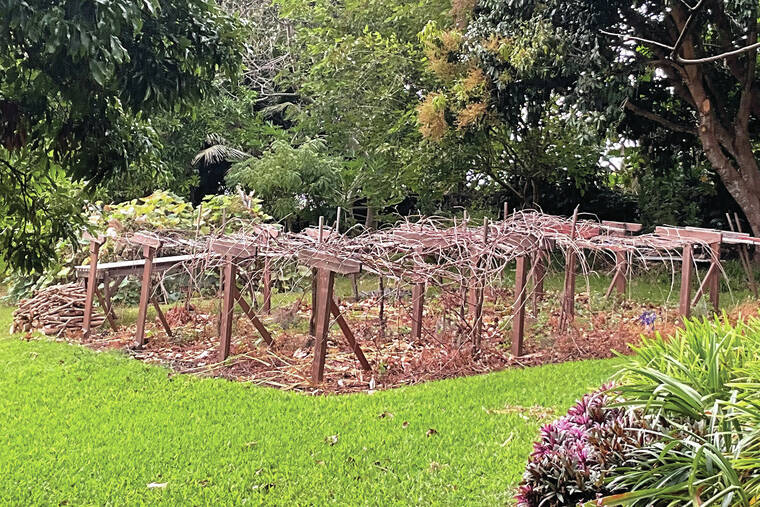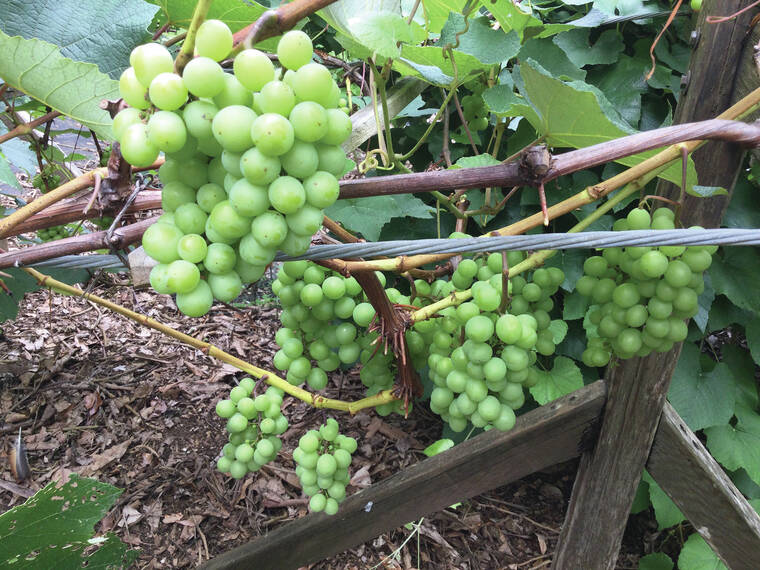When we think of growing grapes, we might recall the expansive vineyards growing in California wine country or a backyard grape vine somewhere on the mainland.
Growing grapes in our sub-tropical climate, however, can be challenging. Gerry Herbert decided to take on the challenge and with the help of a recent SARE grant has discovered some tasty varieties that grow well on his small farm in Honalo.
Gerry had his first viticulture experience while growing up in South Texas. He planted some vines in the caliche soil there and actually harvested his first grapes when he was just thirteen years old. He went on to study viticulture in college in the 1990s and got a degree from UC Davis in Soil Science and Viticulture.
Gerry reports,” During my years at Davis, I learned the importance of using organic practices to build soil health.”
That lesson has stayed with him throughout his years of farming. He actually started serious vetting of grape varieties on his farm in Potter Valley, California a few years after graduation.
He and his wife Nancy Redfeather moved to Honalo in 1998 and began by clearing the land. Within a year, they were growing lots of edible and ornamental plants on their one-acre farm.
It didn’t take long for Gerry to start vetting grape varieties that might grow well on his West Hawaii farm. He began growing grapes there in 2015. He worked with Ken Love from Hawaii Tropical Fruit Growers to get a few scions to start.
When I visited Kawainui Farm in 2017, he had a small vineyard that was just beginning production. Seven years later he is enjoying a bountiful grape harvest in July and August every year.
By 2020, Gerry had done enough research to apply for a supportive grant. SARE is a USDA/NIFA Federal organization that offers competitive grants to fund research and education projects that advance sustainable agricultural practices. Gerry’s research was in process and he was ready to share information about growing this nutritious food source using sustainable and organic growing practices. His work fit the SARE grant requirements perfectly.
Some of the results of his years of research will be available soon in his publication, “Growing Table Grapes in Subtropical Hawaii Using Organic Practices.” The booklet will be available online at the farm website: kawanuifarm.org.
In addition, Gerry has posted several informational videos based on his experiences training and pruning his vines as well as demonstrations of his bagging and propagating practices.
As part of his grant, Gerry ordered scions (cuttings) from the University of California Grape Repository in Davis. Of the nearly 20,000 grape varieties in existence, he ordered only those that showed promise for sub- tropical climates. Of the fifty-eight varieties he planted, he found twelve that he could call “winners.”
According to Gerry, “I want grapes that grow here on tough and hardy vines, that taste good and are somewhat pest resistant.”
In addition to flavor, he and Nancy are seeking grape vines that produce good table grapes, and ones that make good raisins, produce a tasty juice as well as make good jelly. They wanted grapes that froze well and could be kept for a while. Eventually, they may even try making wine from their juices.
The booklet that Gerry and Nancy have produced will carry a full report on their “winners”. This offers alternatives to the Isabella variety that has been grown in Hawaii since the early 1800s. Though Gerry does recommend this variety for home gardeners, he has found several that he prefers for his micro-climate.
Tamiami has become one of the best growing grapes on his farm. It was developed in South Florida by independent grape breeder Joseph Fennell and has been highly productive at Kawainui Farm. It is a good table grape and makes excellent raisins.
Nesbitt, a Muscadine grape variety from Southern Florida is another one Gerry favors for home gardeners. Though not his favorite eating grape, it makes delicious juice and jelly and might be a good one for wine making.
Many of the grape varieties Gerry is growing are likely to survive from sea level up to 2,000 feet in elevation. Since not all of his tested varieties will do well in all of Hawaii’s numerous micro-climates, Gerry’s advice for anyone who wants to grow grapes is to experiment. Eventually you will find one that is best for your location.
Gerry did learn a great deal about growing grapes organically from viticulturist Lon Rombough from Oregon’s Willamette Valley. His book, “The Grape Grower: A Guide to Organic Viticulture” is one Gerry recommends. It gives valuable information that can be applied to grape varieties that will grow in Kona. Rombough’s second book, “The Bountiful Grape: Using Everything the Grape Produces” is full of culinary information for viticulturists.
Part of Gerry’s educational goals is to share not only his knowledge but also some of his scions.
He prunes his vines as they begin budding after a winter dormancy, usually in February. From the cuttings he removes he can usually find ones that make good scions for propagation. A piece of last year’s woody vine that has four buds makes an excellent scion. Placing the scions in the ground or in a pot will likely produce a new plant.
Complete information on growing plants from scions is contained in his new booklet.
Once you get one growing, you want to be sure it has proper support. Gerry uses the Modified Geneva Double Curtain design for his trellises. Check that out online or in his upcoming booklet.
Although annual pruning is essential for good production of grapes, minimal fertilizer and pest control is needed.
Though Chinese rose beetles do like most grape leaves. Some varieties are resistant. Those that aren’t can use the beetles’ defoliation in the fall to help hasten winter dormancy.
Gerry has discovered that compost and other organic amendments along with his thick leaf mulch eliminates weeding, adds nutrients, protects soil moisture and improves soil health. Keeping your soil healthy will keep your plants healthy and likely disease free.
All grape varieties need good soil drainage and, depending on your location, limited irrigation is needed. In rainy season, no irrigation is needed. You need to explore a few features of your location to help choose a grape variety that will thrive where you are. Your elevation and daily temperature range are important. Do you live in a rainy location or one that has wet and dry seasons? If you live in a windy location, you may need to install a wind barrier.
Grapes need sunshine and warmth. If you live in an area that is rainy and cold most of the year, grapes might not be the best choice for you. Select carefully and be patient. It may take three or four years for your vines to produce good quality fruit and another three or four for the best flavors to develop. Know that once you have a variety growing well in your location, you will have grapes for a long time. Grape vines last hundreds of years. Your vines may outlive you.
Diana Duff is a plant adviser, educator and consultant living part time in Kailua-Kona.
Gardening Events Saturday:
•“Work Day at Amy Greenwell Garden” from 9 a.m. to 12:30 p.m. Meet at the Garden Visitor Center across from the Manago Hotel in Captain Cook. Come with a mask and prepared to practice social distancing. Volunteers can help with garden maintenance and are invited to bring a brown bag lunch. Water and snacks provided. Visit the website amygreenwell.garden/get-involved/volunteer-1/ and sign up for the weekly email for more information on work days. Farmer Direct Markets (check websites for the latest hours and online markets)
•Wednesday: “Ho‘oulu Farmers Market” at the Outrigger Kona Resort and Spa Spa at Keauhou Bay Saturday: “Keauhou Farmers Market” 8 a.m. to noon at Keauhou Shopping Center Information on their online market: keauhoufarmersmarket.com/onlinemarket
•“Kamuela Farmer’s Market” 7:30 a.m. to noon at Pukalani Stables “Waimea Town Market” 7:30 a.m. to noon at the Parker School in central Waimea
•“Waimea Homestead Farmers Market” from 7:30 a.m. to noon at the Waimea middle and elementary school playground
Sunday:
•“Pure Kona Green Market” 9 a.m. – 2 p.m. at Amy Greenwell Garden in Captain Cook
•“Hamakua Harvest” 9 a.m. to 2 p.m. at Hwy. 19 and Mamane Street in Honoka’a
Plant Advice Lines Anytime:
konamg@hawaii.edu Tuesdays &Thursdays: 9 a.m. to noon at UH-CES in Kainaliu – 322-4893 or walk in Mon., Tues. &Fri: 9 a.m. to noon at UH CES at Komohana in Hilo 981-5199 or himga@hawaii.edu






